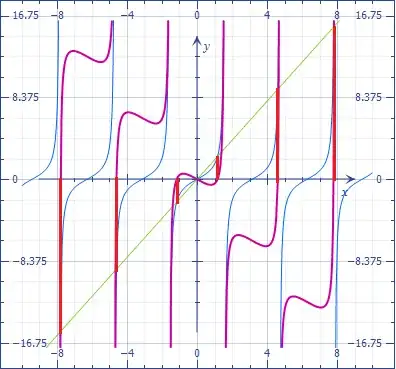Consider that you look for the zero of function
$$f(x)=2x-\tan(x)$$ and forget the trivial solution $x=0$. On the other hand, if $x$ is a root $-x$ is a root too. Then, we need to focus on the positive solution.
In the restricted interval, the derivative $f'(x)=2-\sec ^2(x)$ cancels when $x=\frac \pi 4$ which is a local maximum. So, to get an approximation, build a Taylor expansion around this point and get locally
$$f(x)=\left(\frac{\pi }{2}-1\right)-2 \left(x-\frac{\pi
}{4}\right)^2+O\left(\left(x-\frac{\pi }{4}\right)^3\right)$$ Ignoring for the time being the higher order terms, the approximation is then
$$x=\frac{\sqrt{\pi -2}}{2}+\frac{\pi }{4}\approx 1.31962$$ which is not fantastic.
Adding one extra term to the series expansion would give
$$f(x)=\left(\frac{\pi }{2}-1\right)-2 \left(x-\frac{\pi }{4}\right)^2-\frac{8}{3}
\left(x-\frac{\pi }{4}\right)^3+O\left(\left(x-\frac{\pi }{4}\right)^4\right)$$ which can be solved using Cardano method. The solution would evaluate as $x \approx 1.21193$ which is better.
Now, to really polish the root, as said in comments, a numerical method is required and Newton method will be the simplest. Starting from the first estimate, the iterates would be
$$\left(
\begin{array}{cc}
n & x_n \\
0 & 1.31962 \\
1 & 1.23096 \\
2 & 1.17860 \\
3 & 1.16612 \\
4 & 1.16556
\end{array}
\right)$$
Edit
You could have an approximation using a table lookup since we know the exact trigonometric functions for multiples of $\frac \pi {24}$ (see here). The closest value would be $x=\frac {3\pi} {8}\approx 1.17810$.
Let us repeat the Taylor expansion around $x=\frac {3\pi} {8}$ to get
$$f(x)=\left(\frac{3 \pi }{4}-\cot \left(\frac{\pi }{8}\right)\right)+\left(x-\frac{3 \pi
}{8}\right) \left(1-\cot ^2\left(\frac{\pi
}{8}\right)\right)+O\left(\left(x-\frac{3 \pi }{8}\right)^2\right)$$ and use $\cot \left(\frac{\pi }{8}\right)=1+\sqrt 2$
This will give, as a better estimate,
$$x=\frac {3\pi} {8}+\frac{1}{8} \left(3 \left(\sqrt{2}-1\right) \pi -4\right)\approx 1.16608$$
We could even do better using the simplest $[1,1]$ Padé approximant to get
$$x=\frac {3\pi} {8}+\frac{4 \sqrt{2}+3 \left(\sqrt{2}-2\right) \pi }{8-6 \pi }\approx 1.16557$$
Edit
Since @robjohn gave the value of many solutions outside the range, considering that the $n^{th}$ positive solution $x_{(n)}$ is closer and closer to $(2n+1)\frac \pi 2$, I let $x_{(n)}=(2n+1)\frac \pi 2-\epsilon$ and developed the initial equation as a Taylor series around $\epsilon=0$. Then, using series reversion we get
$$\color{blue}{x_{(n)}=q-\frac{1}{2 q}-\frac{5}{24 q^3}-\frac{83}{480 q^5}-\frac{2407}{13440
q^7}-\frac{856715}{4128768 q^9}+O\left(\frac{1}{q^{11}}\right)}$$
where $\color{blue}{q=(2n+1)\frac \pi 2}$.
For the first solutions, the table below gives the approximation from the above formula as well as the solution obtained using Newton method.
$$\left(
\begin{array}{ccc}
n & \text{approximation} & \text{solution} \\
0 & 1.16949833499836 & 1.16556118520721 \\
1 & 4.60421678800531 & 4.60421677720058 \\
2 & 7.78988375118261 & 7.78988375114457 \\
3 & 10.9499436485421 & 10.9499436485412 \\
4 & 14.1017251335659 & 14.1017251335659 \\
5 & 17.2497818346079 & 17.2497818346079 \\
6 & 20.3958423573092 & 20.3958423573092 \\
7 & 23.5407082923052 & 23.5407082923052 \\
8 & 26.6848024909251 & 26.6848024909251 \\
9 & 29.8283692130955 & 29.8283692130955
\end{array}
\right)$$
